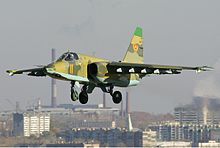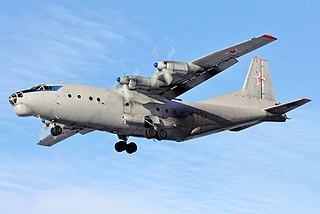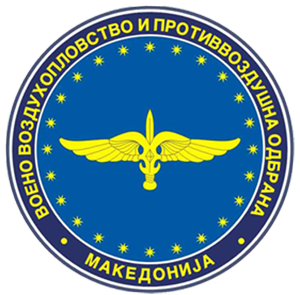
This list is of all operators of the Sukhoi Su-25.

This list is of all operators of the Sukhoi Su-25.












![]() Novorossiya - 1 plane in Luhansk state aviation museum
Novorossiya - 1 plane in Luhansk state aviation museum

The Sukhoi Su-27 is a Soviet-origin twin-engine supersonic supermaneuverable fighter aircraft designed by Sukhoi. It was intended as a direct competitor for the large US fourth-generation jet fighters such as the Grumman F-14 Tomcat and McDonnell Douglas F-15 Eagle, with 3,530-kilometre (1,910 nmi) range, heavy aircraft ordnance, sophisticated avionics and high maneuverability. The Su-27 was designed for air superiority missions, and subsequent variants are able to perform almost all aerial warfare operations. It was designed with the Mikoyan MiG-29 as its complement.

The Ilyushin Il-76 is a multi-purpose, fixed-wing, four-engine turbofan strategic airlifter designed by the Soviet Union's Ilyushin design bureau as a commercial freighter in 1967, to replace the Antonov An-12. It was developed to deliver heavy machinery to remote, poorly served areas. Military versions of the Il-76 have been widely used in Europe, Asia and Africa, including use as an aerial refueling tanker or command center.

The Mikoyan-Gurevich MiG-25 is a supersonic interceptor and reconnaissance aircraft that is among the fastest military aircraft to enter service. Designed by the Soviet Union's Mikoyan-Gurevich bureau, it is an aircraft built primarily using stainless steel. It was to be the last plane designed by Mikhail Gurevich, before his retirement.

The Sukhoi Su-25 Grach is a subsonic, single-seat, twin-engine jet aircraft developed in the Soviet Union by Sukhoi. It was designed to provide close air support for Soviet Ground Forces. The first prototype made its maiden flight on 22 February 1975. After testing, the aircraft went into series production in 1978 in Tbilisi in the Georgian Soviet Socialist Republic.

The Sukhoi Su-24 is a supersonic, all-weather tactical bomber developed in the Soviet Union. The aircraft has a variable-sweep wing, twin engines and a side-by-side seating arrangement for its crew of two. It was the first of the USSR's aircraft to carry an integrated digital navigation/attack system.

The Antonov An-24 is a 44-seat twin turboprop transport/passenger aircraft designed in 1957 in the Soviet Union by the Antonov Design Bureau and manufactured by Kyiv, Irkutsk and Ulan-Ude Aviation Factories.

The Antonov An-12 is a four-engined turboprop transport aircraft designed in the Soviet Union. It is the military version of the Antonov An-10 and has many variants. For more than three decades the An-12 was the standard medium-range cargo and paratroop transport aircraft of the Soviet air forces. A total of 1,248 were eventually built.

The Mil Mi-2 is a small, three rotor blade Soviet-designed multi-purpose helicopter developed by the Mil Moscow Helicopter Plant designed in the early 1960s, and produced exclusively by WSK "PZL-Świdnik" in Poland.

The MolniyaR-60 is a short-range lightweight infrared homing air-to-air missile designed for use by Soviet fighter aircraft. It has been widely exported, and remains in service with the CIS and many other nations.

The Ukrainian Air Force is the air force of Ukraine and one of the seven branches of the Armed Forces of Ukraine. Its current form was created in 2004 by merging the Ukrainian Air Defence Forces into the Air Force.

The Mil Mi-14 is a Soviet shore-based nuclear-capable amphibious anti-submarine helicopter derived from the earlier Mi-8.

The Russian Air Force is a branch of the Russian Aerospace Forces, the latter being formed on 1 August 2015 with the merging of the Russian Air Force and the Russian Aerospace Defence Forces. The modern VVS was originally established on 7 May 1992 following Boris Yeltsin's creation of the Ministry of Defence. However, the Russian Federation's air force can trace its lineage and traditions back to the Imperial Russian Air Service (1912–1917) and the Soviet Air Forces (1918–1991).
The Kh-29 is a Soviet air-to-surface missile with a range of 10–30 km. It has a large warhead of 320 kg, has a choice of laser, infrared, active radar or TV guidance, and is typically carried by tactical aircraft such as the Su-24, Su-30, MiG-29K as well as the Su-25, giving these aircraft an expanded standoff capability.

The Kh-58 is a Soviet anti-radiation missile with a range of 120 km. As of 2004 the Kh-58U variant was still the primary anti-radiation missile of Russia and its allies. It is being superseded by the Kh-31. The NATO reporting name is "Kilter".

Tbilisi Aircraft Manufacturing (TAM), also known as JSC Tbilaviamsheni, is a Georgian aerospace development and manufacturing company, which also partially manufactures APCs and IFVs.

The North Macedonia Air Brigade is the air warfare and air defense force of the Army of the Republic of North Macedonia.

The Turkmen Air Force is the air force branch of the Armed Forces of Turkmenistan. It was formed from former Soviet Air Forces units within that region of the Turkestan Military District. The Turkmen Air Force inherited some 300 Soviet aircraft, and has pilots trained in Ukraine.
{{cite web}}: CS1 maint: bot: original URL status unknown (link). Jane's Defence Weekly, 13 September 2006.